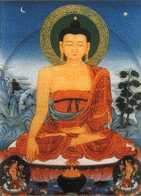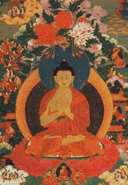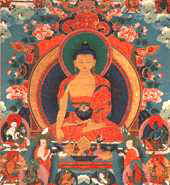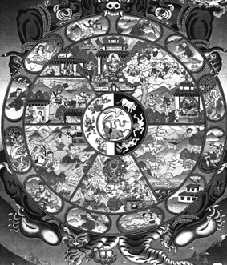
Updates dimanche 05 décembre 2004 13:27

Some basic marks of the Buddhism
Copyright © SâdhanaWe give you here some elementary but indispensable bases of location in the understanding of the Buddhist methodology, the investigation of the mental and in the realization according to the Way of the Environment(middle). They are to know "by heart" in the most essential intimacy of your internal road and should makegradually body with you every day...
Extracts of the book " The Numbers of the Tradition " by vén. Shinjin Robert Brandt-Diény ****** The three Characteristics of the Phenomena 1 - Impermanence or Aniccâ / Anitya - the middle - rtag-pa - this denotes the temporary character of things and phenomena to which we become attached with more or less of intensity, generating so second characteristic- 2 - Dissatisfaction, the suffering, the pain, the misery or Dukkha - sdug-bsngal - this concerns our desires, our affections, our feelings which do not often see their "rewards" and which seeing them arouse the others of it in an unlimited spiral. 3 - Without Essence, the absence of one, or Anattâ / Anâtman - bdag-med-pa - it is the interrelationnality of things and phenomena that, taken remotely, have to be nobody by and themselves. Example. That would be this page without word processor, publishing WEB, site, Internet... And especially without the Internet users, curious and avid to know what is the Basic Buddhism? On the other hand, one finds them formulated as follows:1 - All the aggregates are impermanents and source of suffering
******

The three Confidences
The three Confidences, normally, their place would have of the being literally R as , now, it appears of more imperative, seen the tendency " in the neo-spiritual fast food restaurant " to be taken care spiritually, to define the Faith as a set of confidences which motivate and imply totally our being. The Faith, that one could call the contents, is a phenomenal process totally different from the Faith, faith that one could call the packaging, that one says it himself in sanghas! Please , remind you Little Bouddha: " it is always some tea... ".
Buddham saranam gacchŕmi
Dhammam saranam gacchŕmi
Shangam saranam gacchŕmi...
Dutiyam pi...
Tatiyam pi...
These three fundamental statements of the obedience in the Buddhist rules, recited by several hundreds of million beings by the world. Several times a day, in various places, occasions, traditions, even sects can conceive, besides the way usually explained to the believers(regular customers): I take refuge in the Buddha, the completely awakened, guide beings to whom they expose(explain) the true and pure educations of Dharma, fruits of the Supreme wisdom derived of their direct experience(experiment).I take refuge in Dharma which allows me completely to transcend all the sufferings and leads to the true happiness. Because he supposes the elimination of all the négativités and the fulfillment of all the creative qualities resulting from a set(group) thought - action working by the body, the word and the spirit.
I take refuge in Sangha, the Supreme Community, feet of which are solidly engaged(opened) on the road of the Awakening. I place in her(it) my firm confidence In the spiritual accompanying which I need.
Of two manners which I propose in your sapience:
I put my confidence in the Buddha, the man arisen from some flesh, united with the flesh, finally untied(removed) from some flesh by its spirit which, by its clear-sightedness, discovered the 4 Noble Propositions and became perfectly awake(sharp), realized. By three times, I put my confidence in the Buddha, the Completely awakened, drives(guides) to be to whom it exposed(explained) true and pure education of Dharma, fruits of the supreme Wisdom derived of its direct experience(experiment).I put my confidence in the Education which it(he) distributed, this to free(release) me from my past, present sufferings and to come. By three times, I put my confidence in its Education, really and pure, which allows me to transcend completely the sufferings and leads to the true happiness. He supposes the elimination of all the négativités and the fulfillment of all the creative qualities resulting from a set(group) thought - action working by the body, the word and the spirit.
I put my confidence in mind of the Community of its followers, the laymen and the monk, active in the same essentialité. By three times, I put my confidence in the community of its followers solidly engaged(opened) on the road of the Awakening. In the spiritual competition inherent to this one, allowing me to progress towards the Awakening, I place my confidence.
The second version could formulate so:1 - I recognize the badge privilege to have a Buddha's appropriate(clean) nature 2 - I adhere totally to the Education which will allow me to realize her(it) completely 3 - I become integrated harmoniously into the Community of my fellow men to live this perfectible state to make share the benefactions of it to all the human beings. Let us not forget that the first translators of turned pale and with sanscrit were Christian missionaries who, in spite of all their inborn science, obliterated their translations of a Judeo - Christian note evident occidentalo-moralist. One finds this trinity, angular stone of all the Buddhist building, under the naming of Three Jewels, Three Treasuries. It(he) is to note that they establish(constitute) the first three floors of Stupas or Chorten. There is in Vajrayâna exclusively a fourth refuge, that of the boss, guru or lama. It(he) arises from a late and decadent Buddhism, in the sense(direction) where the worship in the Llama becomes the foundation of the practice, what is against the example of the Buddha himself; the llama, quite as the bhante, sayadaw, sensei is only a vector of transmission of the excellent Education of the Buddha. As such, it(he) deserves a very big respect, but the allegiance which it(he) seems to enjoy the major part of time and which is not without calling back(reminding) the exercise of some excessive privileges by the Christian clergy during the Means - age. At present, in a certain Islam, one would find the same connotation coming from ezbollahs towards ayatollahs, more human than openly spiritually divine. ****** The Three Trainings
The Buddhist discipline according to
1 - The Ethics - Sîla
2 - The mental Discipline - Samâdhi
3 - The Wisdom - Prajńâ
In this stage(stadium), it seemed sensible to reproduce the invaluable rosary, which crystallizes the aspiration of these three trainings.
******
Three Poisons
1 - Greediness, greed, desire - Lobha 2 - Hatred, Anger, jealousy - Measured 3 - Ignorance, illusion, distraction - AvidyaThey are, archétypiquement the three sorts of obstacles to the happiness, certain schools add two of it supplementary to satisfy the "pantheon" of Jînas called wrongly Dhyani-Bouddhas, namely the Jealousy - Issâ, and the Pride - Mana. to see Five
******

The four Noble Essential Propositions
Cattâri Ariyasaccâni - Catvâryâryasatyâni - bden-pa-rnam-bzhi
The four Noble Essential Propositions are more often called the Four Noble Truths, the term of the truth is too peremptory. The term here used(employed) by Proposition is inclined to the experimental check as recommended it Buddha himself to his auditors. The Truth is hurled as the truth without possible contesting, what would contradict the contents of the kalama soűtra... They establish(constitute) the base of the Education of the Buddha, during his first sermon to Bénarčs, when it(he) put in action the Wheel of the (cosmic) Law.1 - Omnipresent existence of the dissatisfaction or suffering (more compatible term with Dukkha) - Dukha-satya - sdug-bsngal-gyi-bden-pa
2 - Origin or causes of the dissatisfaction due to the desire / thirst - Samudâya-satya - kun-'byung-gi-bden-pa
3 - Cessation of the dissatisfaction by abandoning the desires / thirst - Nirodha-satya - ' gog-pa'i-bden-pa 4 - Path leading to the cessation of the dissatisfaction by the fulfillment of the eight stages leading to the Wisdom or Noble Octuple Sentier - Mârga-satya - lam-gyi-bden-pa Dissatisfaction denotes more the character of imbalance than the term of suffering which, her(it), is more a change, a bruise, established facts consecutive to the dissatisfaction which generates them. ****** The four Buddhist Wishes1 - I make the wish save beings, so numerous they are. 2 - I make the wish eliminate my so numerous, worldly desires they are. 3 - I make the wish reach the perfect Knowledge of the Education, however unlimited it is. 4 - I make the wish reach(affect) the ultimate Awakening, however far he can be. Naturally, there is a quantity of the other formulations of these wishes which can be more numerous moreover. Here, reproduced a formulation of these. ******
The five Aggregates or constituents of the person - Skandha
They accompany every human being of his conception in his death, certain Buddhist schools go so far as to say as they are constituent of the ego...1 - Rűpa: the shape, the physical appearance, the material in a worldly sense(direction), a material - gzugs-kyi-phung-po 2 - Vedanâ: the sensation of three sorts, the felt in the sense(direction) of impression(printing) - tshor-ba'i-phung-po
3 - Samjńâ: the perception, the notion of, the observation of - ' of - shes-kyi-phung-po
4 - Samskâra: the forming(training) of the intellect, the efforts of the will, the conditionnantes forces, the unconscious tendencies - ' of - byed-kyi-phung-po
5 - Vijńâna: the consciousness, the awareness - rnam-par-shes-pa'i-phung-po, one sometimes gives him(her) the word of knowledgeAnother naming looks:
1-physical constituents-
Road of the Accumulation-
Road of the Effort road of the Effort-
Road of the Understanding or deep vision road of the Understanding or deep vision-
Road of the Development road of the Development-
Road of the Realization or Liberation road of the Realization or LiberationThese five stages are ranging-poles to begin gradually, completely to become aware of the application of the Way of the Environment(middle) and be there , by this fact, so completely aware(conscious), otherwise this practice would restrict itself only to an aspect ritualiste without any spirituality.
******
The five Obstacles
to the progress towards the Awakening - The greed -
- The bad will -
Vyapada- The laziness -
Styana-moddha- The obsessing ideas -
Auddhyata-kaukrita- The doubts -
VicikitsăAs long as these elements remain, your spirit is diverted(hijacked) from its inhalation(pursuit), from its motivation first and fundamental to know, the liberation of the suffering, the dissatisfaction.
****** Five PoisonsThey correspond to five colours (red, blue, white, green, yellow) Jînas or cosmic principles of Wisdom which are sensible to represent their antidotes. One finds them symbolically, in some tangkhas and mandalas, due to the their respective colours
1 - The Greediness - Lobha
2 - The Anger - Measured
3 - The Ignorance - Avijjâ
4 - The Jealousy often associated to the hatred - Issâ
5 - The Pride - Manâ
Here, their list is given alphabetically, in view of the different interpretations according to Vehicles and schools, some by recognizing only three.
******
The Five Rules of the layman with turned pale statement
1 - I shall try hard to observe the rule not hurting the life, or making remove the life to some human being - Pŕnŕtipŕtŕ veramani sikkhŕpadam samŕdiyŕmi
2 - I shall try hard to observe the rule not taking what is not given to me - Adinn' ŕdŕnŕ..
3 - I shall try hard to observe the rule not following the bad behavior by not abandoning me to sensual desires -
Kŕmesu-micchŕ-cŕrŕ.. 4 - I shall try hard to observe the rule refraining to me of unrefined, useless and deceitful words - Musŕvŕdŕ... 5 - I shall try hard to observe the rule refraining to me of drugs, intoxicants and strong alcohols engendering the carelessness - Surŕmerayamajjapamŕ-datthŕnŕ...******
Six Paramitas
Or Perfections to be cultivated
1 - The generosity, the gifts(donations), the antidote of the greediness - Dâna
2 - The morality based on the ethical rules(rulers), the antidote of the lust - Sîla
3 - The patience, the perseverance, the antidote of the anger - Being Khsânti
4 - The watchful energy, the antidote of the laziness - Vîrya
5 - The consideration, the antidote of the entertainment - Dhyâna
6 - The Wisdom or the transcendental knowledge, the antidote of the silly thing or the ignorance - Prajńâ
The perfections, according to schools, vary from six to ten, among which here are the four following ones:
7 - The renunciation - nekkhama - Nayskramya
8 - The resolution - adhitthâna - Adisthâna
9 - The truth - sacca - Satya
10 - The equanimity - upekkha - Upeksâ
It happens that Dhyana is replaced by the benevolence - metta - Maîtrî
They are beneficial elements to cultivate most intensely to reach the understanding of its dissatisfaction, the detachment of its ego and the altruistic condolence. The term of perfectibilité is more just, because it implies the movement towards, the effort to make to realize her(it) in the impermanence.
******
The seven factors of Awakening
1 - The attention, the presence of mind
- sati - smriti2 - The study of the education, the investigation of things
- dhammavicaya - dharmavicâra3 - The energy
- viriya vîrya4 - The enjoyment
- pîti - prîti5 - The tranquillity
- passadhi - prashradhi6 - The serenity, location of the psyche
- samâdhi 7 - The equanimity, the imperturbability - upekhâ - upekhsâIt is the capacities that every person should implement(operate), work and refine the most possible to gather(reunite) the optimal conditions in its personal progress.
******

Eightfold Noble Path according to Eight steps
Ariya anthangika magga
- Just or correct understanding (sammâ ditthi) things and phenomena - Just thought (sammâ sankappa) just intention according to the just understanding (certain translations give intention or just decision) - Just word (sammâ vâcâ) according to the major rules concerning her(it) - Just action (sammâ kammanta) according to the major rules - Just(right) livelihood (sammâ ajîva) according to the major rules. - Just effort (sammâ vâyâma) - there is different four: To avoid, Surmount, Develop, Maintain - Just attention (sammâ sati) - there is different four: in the body, in the sensations, in the spirit, in the phenomena. - Just concentration (sammâ samâdhi), bases all other stepsIt is the Way of the Buddha, the common-core syllabus of all the Buddhist schools and the keystone of the Education of the Buddha. With the three Characteristics, the four Noble Propositions, the five Aggregates, the six Perfections, the seven Factors, the ten Links and the twelve Links of the Wheel of the Life, it is the main educations which every Buddhist boss owes fundamentally and honestly teach before any ésotérique practice... It(he) is to underline that these eight not of ONES are strictly and interelationnellement been linked, each not being able to be really without the others. (Many confirmed followers, followers know him(it) sometimes only very imperfectly even at all, for the benefit of " ultra-fast methods " or of " silencéité without road "...!).
This Noble Octuple Sentier owes (rather would must) be known by heart by all those who refer to the Buddha …
******
The ten Links of the Wheel of the existence
Or the ten Obstacles to the concentration - samyojana
1 - The illusion of the one -
sakkâya ditthi - false faith in the personality2 - The doubt -
vicikicchâ - the scepticism towards the Educations3 - The affection in the rites and in the ceremonies -
sîlabbata-parâmâsa - to grant(tune) a false confidence in the value of the rules and the rites4 - The sensual desire -
kâma-râga5 - The bad will -
vyâpâda - the wickedness6 - The desire of the world of forms -
rűpa râga - desire of the material existence7 - The desire of the world without forms -
arűpa râga - desire of the immaterial existence8 - The pride -
mâna - expresses the mindless respect of its ego9 - The excitement -
uddhacca - the mental anxiety 10 - The ignorance - âvidyâ - state in which one is plunged in the absence of knowledgeIt is a more complete shape of the obstacles to any awareness, to any confidence, to any reassurance.
******
Ten Stains or
Klesha or Klesha1 - Greediness, desire, greed:
lobha2 - Hatred, anger, bad intention, aggressiveness, hostility:
measured3 - Illusion, stupidity, distraction:
moha4 - Vanity, pride, arrogance, conceit:
mâna5 - Opinion, erroneous sights, faiths, dogmae:
ditthi6 - Doubt, scepticism, perplexity, uncertainty, hesitance:
vicikicchâ7 - Mental torpor, laziness, steepness, intransigence:
thîna8 - Excitement, emotion, overstrain:
uddhacca9 - Absence of shame relative to the consequences of bad actions, the words, the thoughts:
ahirika10 - Absence of fear relative to the consequences of bad actions, the words, the thoughts:
anottapa These stains or obstacles to the awakening are stemming formings(trainings) of mental hindering our liberation of the suffering.******

The twelve links of the Wheel of the Life
Nidanas of the Paticca-samutpâda
This Wheel of the Life is also called Law of the Causality, the first link is the cause of the following one et cetera, It is represented very symbolically in the Tibetan paintings and symbolizes the cycle of the lives and the revivals from which the human being should inhale(suck up) to release himself. 1 - The ignorance in which is plunged to be non-awakened to everything - Avidyâ 2 - The ignorance engenders the action with its karmique influence - Samskâra 3 - The action engenders the consciousness - Vijńâna 4 - The consciousness engenders the name and the shape - Nâmarűpa 5 - The name and the shape engender the six organs of the senses(directions) - Shadâyatana 6 - The six organs of the senses(directions) engender the contact - Sparsha 7 - The contact engenders the sensation - Védâna 8 - The sensation engenders the desire - Trishnâ 9 - The desire engenders the affection - Upâdanâ 10 - The affection engenders existence - Bhava 11 - The existence engenders the birth - Jâti 12 - The birth engenders the old age and the death - KarâmanaBy eliminating the ignorance, one eliminates the following eleven links.
Twelve links are considered as acting in the three phases of the life:
Past - present - future
The ignorance and the action take their causes in the past life
Of - the consciousness in the sensation - act in the present life
Of - desire in the existence - have their causes in the present life
Finally the birth, the old age and the death will have effect in the future life.
******